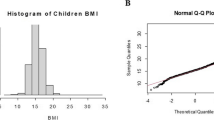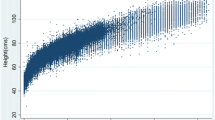Abstract.
Nutritional status of a child is an important determinant factor of his/her health and survival. Evaluation of child nutritional status is usually based on three anthropometric indices of height-for-age (stunting), weight-for-height (wasting) and weight-for-age (underweight). This paper is a case study that focuses on a new approach of estimating nonlinear effects. It models the dependence of probability of underweight children in Zambia on some covariates, some of which are metrical whose effects are assumed to be nonlinear and estimated nonparametrically through a Bayesian B-spline basis function approach with adaptive knot selection using the data set from the 1992 Zambia Demographic and Health Survey (ZDHS). For all the unknown functions, the number and location of knots as well as the unknown coefficients of the basis functions are estimated simultaneously using reversible jump Markov chain Monte Carlo (RJMCMC) techniques.
Similar content being viewed by others
Author information
Authors and Affiliations
Corresponding author
Rights and permissions
About this article
Cite this article
Adebayo, S.B. Modelling childhood malnutrition in Zambia: an adaptive Bayesian splines approach. Statistical Methods & Applications 12, 227–241 (2003). https://doi.org/10.1007/s10260-003-0057-z
Issue Date:
DOI: https://doi.org/10.1007/s10260-003-0057-z




